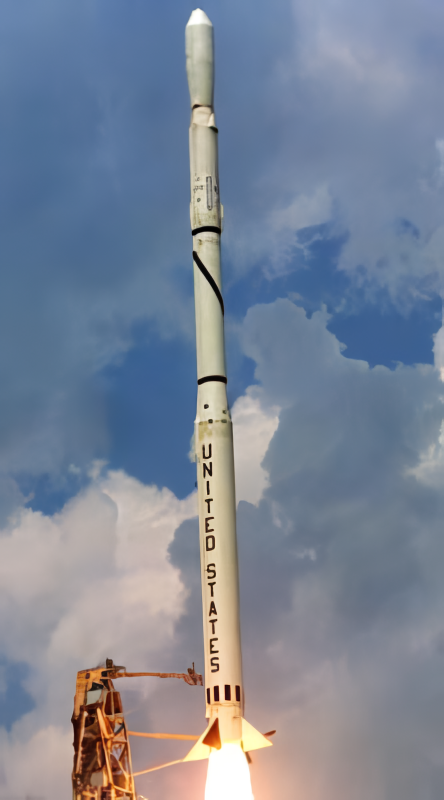
Scout B
In-activeVought ()
Aug. 10, 1965
Description
The Scout family of rockets were were American launch vehicles designed to place small satellites into orbit around the Earth. The Scout multistage rocket was the first orbital launch vehicle to be entirely composed of solid fuel stages.
Specifications
-
Stages
4 -
Length
25.0 m -
Diameter
1.01 m -
Fairing Diameter
1.01 m -
Launch Mass
17.0 T -
Thrust
513.0 kN
Family
-
Name
Scout B -
Family
― -
Variant
B -
Alias
― -
Full Name
Scout B
Payload Capacity
-
Launch Cost
$8660000 -
Low Earth Orbit
143.0 kg -
Geostationary Transfer
Orbit
― -
Direct Geostationary
― -
Sun-Synchronous Capacity
―
Vought
Commercial
None
1917Vought was the name of several related American aerospace firms. These have included, in the past, Lewis and Vought Corporation, Chance Vought, Vought-Sikorsky, LTV Aerospace (part of Ling-Temco-Vought), Vought Aircraft Companies, and Vought Aircraft Industries. The first incarnation of Vought was established by Chance M. Vought and Birdseye Lewis in 1917. In 1928, it was acquired by United Aircraft and Transport Corporation, which a few years later became United Aircraft Corporation; this was the first of many reorganizations and buyouts. During the 1920s and 1930s, Vought Aircraft and Chance Vought specialized in carrier-based aircraft for the United States Navy, by far its biggest customer. Chance Vought produced thousands of planes during World War II, including the F4U Corsair. Vought became independent again in 1954, and was purchased by Ling-Temco-Vought in 1961. The company designed and produced a variety of planes and missiles throughout the Cold War. Vought was sold from LTV and owned in various degrees by the Carlyle Group and Northrop Grumman in the early 1990s. It was then fully bought by Carlyle, renamed Vought Aircraft Industries, with headquarters in Dallas, Texas. In June 2010, the Carlyle Group sold Vought to the Triumph Group.
Scout B | SSS 1
Vought | United States of AmericaBroglio Space Center, Kenya
Nov. 15, 1971, 5:52 a.m.
Scout B | BIC
Vought | United States of AmericaWallops Flight Facility, Virginia, USA
Sept. 20, 1971, 11:31 p.m.
Scout B | Solrad 10
Vought | United States of AmericaWallops Flight Facility, Virginia, USA
July 8, 1971, 10:58 p.m.
Scout B | San Marco 3
Vought | United States of AmericaBroglio Space Center, Kenya
April 24, 1971, 7:32 a.m.
Scout B | Uhuru
Vought | United States of AmericaBroglio Space Center, Kenya
Dec. 12, 1970, 10:53 a.m.
Scout B | OFO
Vought | United States of AmericaWallops Flight Facility, Virginia, USA
Nov. 9, 1970, 6 a.m.
Scout B | Azur
Vought | United States of AmericaVandenberg SFB, CA, USA
Nov. 8, 1969, 1:52 a.m.
Scout B | ESRO 1B (Boreas)
Vought | United States of AmericaVandenberg SFB, CA, USA
Oct. 1, 1969, 10:29 p.m.
Scout B | ESRO 1A (Aurorae)
Vought | United States of AmericaVandenberg SFB, CA, USA
Oct. 3, 1968, 8:49 p.m.
Scout B | RAM C-2
Vought | United States of AmericaWallops Flight Facility, Virginia, USA
Aug. 22, 1968, 3:16 p.m.
Scout B | Explorer 39
Vought | United States of AmericaVandenberg SFB, CA, USA
Aug. 8, 1968, 8:12 p.m.
Scout B | ESRO 2B
Vought | United States of AmericaVandenberg SFB, CA, USA
May 17, 1968, 2:06 a.m.
Scout B | Explorer 37
Vought | United States of AmericaWallops Flight Facility, Virginia, USA
March 5, 1968, 6:28 p.m.
Scout B | OV3-6
Vought | United States of AmericaVandenberg SFB, CA, USA
Dec. 5, 1967, 1:03 a.m.
Scout B | RAM C-1
Vought | United States of AmericaWallops Flight Facility, Virginia, USA
Oct. 19, 1967, 5:33 p.m.
Scout B | ESRO 2A
Vought | United States of AmericaVandenberg SFB, CA, USA
May 30, 1967, 2:06 a.m.
Scout B | San Marco 2
Vought | United States of AmericaBroglio Space Center, Kenya
April 26, 1967, 10:06 a.m.
Status: Launch Successful
Mission:
San Marco 2 was a 66-cm-diameter spherical satellite with two experiments, one designed to make direct measurements of air density below 350 km, and the other an ionospheric beacon experiment developed to observe electron content between the earth and the satellite.
Low Earth OrbitScout B | OV3-5
Vought | United States of AmericaVandenberg SFB, CA, USA
Jan. 31, 1967, 12:45 p.m.
Scout B | OV3-2
Vought | United States of AmericaVandenberg SFB, CA, USA
Oct. 28, 1966, 11:56 a.m.
Scout B | OV3-3
Vought | United States of AmericaVandenberg SFB, CA, USA
Aug. 4, 1966, 10:45 a.m.
Scout B | OV3-4
Vought | United States of AmericaWallops Flight Facility, Virginia, USA
June 10, 1966, 4:15 a.m.
Scout B | OV3-1
Vought | United States of AmericaVandenberg SFB, CA, USA
April 22, 1966, 9:45 a.m.
Scout B | SEV
Vought | United States of AmericaWallops Flight Facility, Virginia, USA
Aug. 10, 1965, 5:54 p.m.
Long March 3B/E
Fengyun-4C
Launch Complex 2 (LC-2) - Xichang Satellite Launch Center, People's Republic of ChinaChina's geostationary meteorological satellite program FY-4 (Feng Yun 4) is the second generation of chinese geostationary meteorological satellites.
Long March 8A
SatNet LEO Group 17
Commercial LC-1 - Wenchang Space Launch Site, People's Republic of ChinaA batch of 9 Low Earth Orbit communication satellites for the Chinese state owned SatNet constellation operated by the China Satellite Network Group.…
Soyuz 2.1a
Obzor-R No.1
43/4 (43R) - Plesetsk Cosmodrome, Russian FederationNote: Assignment of payloads to this launch is uncertain. The Russian Obzor-R satellite is a planned X-band radar earth observation satellite desi…
LVM-3 (GSLV Mk III)
BlueBird Block 2 #1
Satish Dhawan Space Centre Second Launch Pad - Satish Dhawan Space Centre, IndiaAST SpaceMobile’s Block 2 BlueBird satellites are designed to deliver up to 10 times the bandwidth capacity of the BlueBird Block 1 satellites, requi…
Long March 12A
Demo Flight
Long March 12A Pad - Jiuquan Satellite Launch Center, People's Republic of ChinaFirst test launch of CASC/SAST’s Long March 12A rocket, with a dummy payload. The rocket’s 1st stage attempted to land on a landing pad about 300 km …

